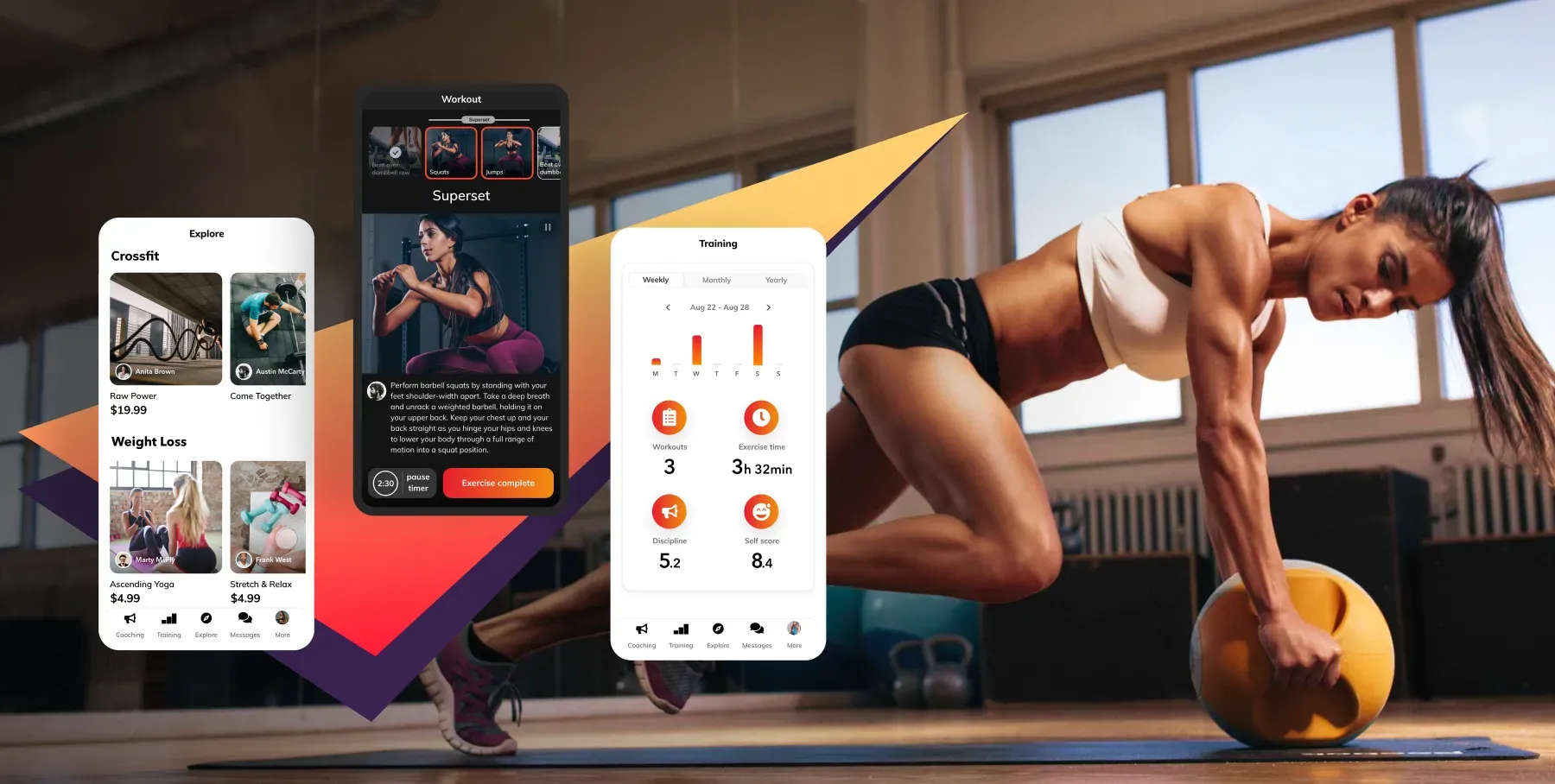Successful fitness app roadmap

In 2025, the trend towards healthy living is still going strong. More and more people are motivated to be fit and healthy, and this presents a great opportunity for those thinking about developing a health and fitness app. The demand for such apps is high, and with the right strategy, your app can stand out in a crowded market.
A promising market of fitness apps
According to a recent report by Statista, the total revenue from digital fitness and well-being apps reached almost $25.38bn in 2022, almost double what it was in 2019. This market is expected to continue growing at an annual rate of 14.72%, reaching a projected volume of $43.96bn by 2026.
Statista also reports that user penetration is expected to hit 15.92% by 2026, with the average revenue per user estimated at $26.64. The majority of revenue is expected to be generated in China, with $6,054.00m in 2022.
In addition, health and fitness apps have been seeing rising retention rates between Q3 2020 and 2022, with a growth of 15.6%. Retention rates measure app usage and loyalty, which directly impact app revenue. The growing retention rate suggests that the market is not yet oversaturated with intense competition.
Health and fitness app development trends
The trend towards health and fitness app development continues to grow strong, with people increasingly looking for ways to improve their health and fitness from the convenience of their mobile devices. As such, there are many opportunities for developers to create unique and profitable products in this space.
One key trend in health and fitness app development is the combination of online and offline experiences. Mobile devices have become an integral part of our lives, and fitness apps can now provide users with guidance, motivation, and accountability, giving them more control over their health and fitness.
Another trend is the rise of personalization and customization. Many fitness apps now include features that allow them to analyze users' activity and nutrient intake, as well as other complex health parameters from wearable devices. This provides unprecedented opportunities for personalization, ensuring users get exactly what they need, when they need it.
There are three main types of fitness mobile apps:
- Online fitness and workout apps, which provide users with fitness programs, yoga and meditation practices, and other workout guidance. Examples include Calm, Fitbit, and 7 Minute Workout.
- Diet and nutrition apps, which help users plan their meals and maintain a balanced nutrition intake. Examples include MyFitnessPal, Fooducate, and Carb Manager.
- Activity tracking apps, which help users monitor and track their sports activities and sleep, as well as other health parameters. These apps are often paired with wearable devices and can be used for tracking specific health needs. Examples include Strava, C25K, and HealthifyMe.
What makes a fitness app successful?
To understand what makes a fitness app successful, it's useful to look at the top health and fitness apps of 2022. Based on data from SimilarWeb and Statista, the key success factors of developing a fitness app include offering flexible subscription options, providing personalized experiences, incorporating high-quality data and engaging content, delivering a smooth and bug-free user experience, and responding quickly to user feedback and reviews.
Fitness apps that offer flexible subscription options tend to be more successful and make more money. Personalization is also important, as 71% of consumers in the US want personalized interactions. High-quality data and engaging content, such as workout tutorials and nutrition advice from health experts, can also boost the value of a fitness app.
Finally, a fitness app should be well-designed, with a smooth user experience and no bugs. Responding to user feedback and reviews can help build a stronger bond with the app's community and improve the product.
How to monetize a fitness app?
There are several ways to monetize a fitness app, including:
- Freemium: This monetization model allows users to access basic features of the app for free, but advanced features are available for a fee. This can help build trust and loyalty with users before offering paid options.
- Subscriptions: With subscriptions, users pay for access to exclusive content on a weekly, monthly, or annual basis, often after a free trial.
- In-app advertisements: This model gives users free access to the app, but includes ads to generate revenue. Users can pay a fee to remove the ads.
- In-app purchases: The app itself can be free, but users can pay for specific programs or services, such as weight loss programs or one-time consultations with a coach.
- Paid apps: With this model, users must pay a set fee to use the app after a free trial is available. This option is typically less effective for fitness app monetization.
Ultimately, the best monetization strategy for a fitness app will depend on market analysis and user research.
Must-have fitness app features
To create a successful fitness app, consider incorporating the following features:
- Personal profile: This feature allows users to enter personal information, set goals, and track their progress.
- Diaries: This feature allows users to track their daily activities, such as food intake and exercise, and provides suggestions for improvement.
- Expert blog and recommendations: This feature provides users with access to exclusive content and expert advice, personalized to their needs.
- Catalog of courses or special programs: This feature offers users access to specialized programs, such as weight loss plans and workout routines, for a fee or for free.
- User content: This feature allows users to share their achievements and experiences on social media, increasing engagement and attracting new users.
- Social media sharing: This feature allows users to share their progress and app content on social media platforms, providing motivation and support from friends.
Step-by-step: fitness app development
To develop a fitness app, follow these steps:
- Investigation/discovery phase: In this phase, conduct a competitive analysis and research your target audience to refine your product concept and prepare a technical specification. Decide on a monetization model and define MVP features, as well as build a UI kit.
- Choose technologies: Consider native app development for the best performance, or cross-platform development using the Flutter framework for a cost-effective solution.
- Prototyping and design: Create wireframes, design the app, and create a prototype. Test the prototype and evaluate the results.
- Fitness app development and support: Develop the MVP and test the app. Consider hiring an in-house team, working with freelancers, or outsourcing the project to a development company.
- Launch, track, and maintain: After the initial release of the app, gather feedback and create a roadmap for further development. Promote the app and launch marketing campaigns, and analyze user behavior to increase engagement.
How much does it cost to build a fitness app?
The cost of developing a fitness app can vary depending on factors such as the app's features, technology stack, UI/UX design, and the expertise of the development team. The cost of an MVP from a reliable development agency can start at around $50,000, with the cost of a full version ranging from $100,000 to $250,000. To get a more precise estimate for your specific requirements, it is best to consult with a development partner.
Summary
Developing a fitness app can be challenging and costly, but partnering with a reliable development company can make the process smoother and more successful. A development partner can provide expert insights and help create the best app possible. While the development team focuses on building the app, you can focus on financial issues, promotion, and user acquisition.
